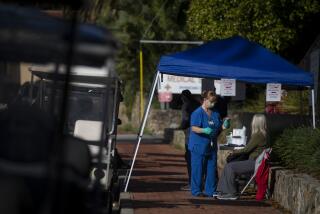Reinforce the Thin Gray Line Separating Us From the Hot Zone
- Share via
Anyone who has ever read the book “The Hot Zone” knows how frightening the introduction of a rabid infectious disease into a population can be. Los Angeles is a prime target for such a perilous breakout. We’re an international city with a large, poorly documented sub-population that has minimal access to resources, including sanitation, and is tightly jammed into a core central area of the city frequented daily by more affluent workers from suburbs near and far: a perfect setup for one of those nasty little viruses to slip across class lines. We’ve already seen tuberculosis, caused by a big fat slow-growing bacterium resistant to most of the antibiotics we can throw at it, wiggle free and become a threat to us all.
And what is Los Angeles’ main defense against the introduction of a virulent pathogen into our huge population? A thin gray line of health centers and clinics whose base is a tired old hospital built when many of the diseases we fear most today hadn’t even been discovered: Los Angeles County-USC Medical Center, which is mandated to be the receiving hospital for infectious diseases brought from abroad and needs more state-of-the-art isolation beds to perform this mission.
Each week, I take enthusiastic young medical students up to one or another of the wards at County-USC to learn how to be good clinicians. The dark old building is for them a stark contrast to USC’s top-of-the-line, fully computerized University Hospital. At County-USC, a ward of six patients has only one small cubbyhole of a bathroom. Windows installed in the 1930s look down on stacks of other dingy gray buildings. No pictures hang on the walls, no plush carpets hide the weather-worn floors. But these amenities are of no consequence compared with the big flaws in the old building whose plans were drawn up shortly after World War I. There is no sprinkler system, so the county pays $1 million a year for people to prowl the halls looking for fires. And if there were a fire, patients’ lives would be in jeopardy because the stairwells all lead to the center of the hospital rather than to the outside.
The need for a new county hospital was recognized way back in 1965, when Los Angeles’ population was considerably smaller and communicable diseases weren’t the risk they are now, when modern transportation can bring a virus from the innards of Africa to our doorstep in a plane ride’s time.
Today is D-Day for old County-USC. That the hospital needs to be replaced is undeniable; the size of its replacement is what the Board of Supervisors will debate. Eighty-five million dollars have been spent drawing up plans for a new 750-bed hospital, which several knowledgeable groups have stated is minimally acceptable. Yet some supervisors reportedly feel that 500 or 600 beds are all the new hospital needs. Should a smaller facility be voted in, new plans would be needed. Consider that during the 1996-97 fiscal year, County-USC was budgeted for 860 beds and had an average daily census of 865 beds in use. The difference in annual debt between a 500-bed and a 750-bed hospital is about $11 million, an insignificant cost when you consider that total operating costs are about $650 million a year.
So why do some supervisors want to shortchange the community by 150 to 250 beds? Federal law doesn’t allow emergency rooms to transfer sick indigent patients until another facility agrees to accept them and they are stabilized. A small County-USC simply won’t be able to accept such patients, and private hospitals will be out-of-pocket for the costs of treating them.
How will the private hospitals fight back? Traditionally, they’ve charged paying patients more, but a new trick is to close their emergency rooms. If sick, nonpaying patients have no way of getting into a hospital, then the federal rules can’t apply. We’ve already seen a similar scenario played out with our crippled trauma system, which has dropped from 25 to 13 participating hospitals over the past few years. Bottom line? Don’t expect your local hospital to have an open ER when you come calling with your heart attack.
UCLA plans to build a 500-bed hospital, largely for private patients, at a cost of close to $100 million more than the proposed County-USC, which cares for about 12 times the number of indigent patients. Granted, some UCLA funding is private. Their half of town has many more movie stars and media moguls than does ours. But the medical needs of the indigent affect us all. Viruses and bacteria have no road maps, and a well-equipped County-USC will mean better health for all.
More to Read
Sign up for Essential California
The most important California stories and recommendations in your inbox every morning.
You may occasionally receive promotional content from the Los Angeles Times.













